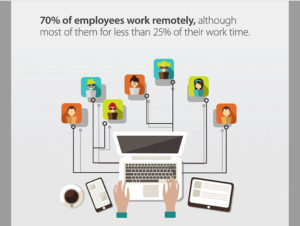6 tips to keep remote employees engaged
Incentives, clear guidelines and scheduled check-ins will help you get the most out of your virtual workforce
Five years ago, the idea of having your staff work remotely from home seemed farfetched. One or two with extenuating circumstances? Sure. A contractor who’s out-of-town? Made sense. But your entire staff?
“If you looked on LinkedIn today, there are more remote jobs than there have ever been in history,” says Vistage member Ken Zwerdling, CEO and founder of Foreign Staffing, a bilingual recruiting and staffing firm. “It’s becoming more acceptable.”
Zwerdling should know. His company not only helps staff Fortune 500 companies with remote employees, it is made up of mostly remote employees. Zwerdling is based in Greensboro, South Carolina, while the bulk of his staff works out of The Philippines.
Polling shows remote employment trending upward
And it’s a trend many are following. According to polling information from the U.S. Census Bureau, the number of employees either working from home or telecommuting grew 103 percent between 2005 and 2014. In the recent Q3 2016 Vistage CEO Confidence Index, 74 percent of respondents have employees that work from home.
“When I went and started working in my home running a consulting firm 20 years ago, there was a stigma attached to it,” Zwerdling says. “Today there’s no more stigma. It’s just common sense.”
There are several benefits to having employees work from home. For starters, you can hire the best talent from anywhere in the world, says Jay Friedman, a partner and chief operating officer of the Dallas, Texas-based Goodway Group, a managed-services programmatic media firm. You can also hire from places where salary requirements aren’t as high as large municipalities like New York and lower costs by not having to rent out office space and equipment.
But perhaps the biggest benefit is giving employees the added flexibility of working at their own schedule and pace, Friedman says.
“We believe in work/life integration,” he adds. “We understand that people will work at night or on a weekend but, as a result, take time during the day for personal things. The integration offers tremendous responsibility and freedom, which our employees appreciate and pay us back in spades.”
Productivity high among those working remotely
A 2014 study published in the Harvard Business Review confirms that remuneration. Nicholas Bloom, an economics professor at Stanford, studied a group of employees from the Chinese travel site Ctrip who were allowed to work from home for nine months.
The study found that during that time, the remote employees “completed 13.5% more calls than the staff in the office — meaning that Ctrip got almost an extra workday a week out of them. They also quit at half the rate of people in the office.”
But there are some drawbacks. Team communication may drop because people aren’t in the same office bouncing ideas off one another, Zwerdling says. And there is the possibility that some may take advantage of the policy.
Engagement the key to remote success
So how do you keep them engaged? Zwerdling has 6 tips:
- Develop a system. Keep employees engaged by setting up a cloud-based system where you can track their workflow. In Zwerdling’s case with Foreign Staffing, employees submit weekly activity reports where he can look over what team members’ projects and how much time they’re spending on their work. “We can check in with each other,” he says. “Everything is in the cloud. Everybody can collaborate from anywhere.”
- Have weekly meetings. Thank goodness for Skype, says Zwerdling. With that, he can arrange weekly staff meetings with his team to make sure deadlines are being met and that issues regarding assignments can be brought up quickly and handled. “You get six bodies on your screen and everybody goes around and talks to each other,” Zwerdling says.
- Learn the tools you’re using to run your business. This seems obvious, but getting a handle on all the technology that runs a remote business can help you when problems arise. It can stave off technology hiccups, which can lead to communications and productivity breakdowns, but can also save you big bucks. “Now I don’t need to hire an IT firm and pay them ridiculous amounts a month,” Zwerdling says.
- Keep them accountable. Once you’ve hired an employee, make sure you 1) set specific expectations in terms of output, 2) confirm that they’re adhering to those expectations and 3) call them out if they don’t comply. Again, this is where setting up detailed policies, procedures and check-ins help with accountability, Zwerdling says. “I don’t talk to every one of my employees every day, but I know that they are sitting at their desks, and if I reach out to them, they’re there,” he says. “If you don’t have the regulations and policies in place, it just won’t work.”
- Incentivize. Zwerdling gives employees the chance to new learn skill sets and expand their abilities by providing free online training and tutorials via Lynda.com. Typically, employees get training in project management, marketing and social media, among other topics. “You want to give them a chance to improve their situation,” he says.
- Bonuses still work. While you might be lowering costs by paying less for an employee outside of the United States consider pulling some of those savings from the bottom line to provide bonuses following performance reviews or end-of-the-year evaluations, Zwerdling says. “You give them a bonus of a few hundred dollars and you’re helping to give them a sustainable life,” Zwerdling says. “These people are much more dedicated than my other employees.”
Category: Performance Management / HR
Tags: Human Resources, running a business remotely, Workplace Culture


